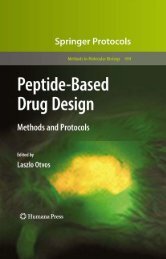You also want an ePaper? Increase the reach of your titles
YUMPU automatically turns print PDFs into web optimized ePapers that Google loves.
Cationic Antimicrobial <strong>Peptide</strong>s 149<br />
use of z values to reduce the number the variables used for analysis of lactoferricin<br />
derivatives, the number of peptides (the number of equations) is still<br />
small compared to the number of variables. While techniques such as PLS or<br />
PCA can be used to produce models based on this amount of data, other powerful<br />
modeling techniques will not work. In addition to having more confidence in<br />
parameter estimation, having much more data than number of variables also<br />
allows more definitive determination of model performance using techniques<br />
such as cross-validation whereby a representative fraction of the data is set aside<br />
for testing after models have been built on the remaining data.<br />
Another limitation of published QSAR studies into antibacterial activity of<br />
peptides is due to the types of models used. Both PCA and PLS produce models<br />
that are linear with respect to the QSAR descriptors. Often the choice to use<br />
simpler linear models is made deliberately (e.g., as stated [76,77]) sincethe<br />
resulting models allow straightforward interpretation for predicting improvements<br />
in peptide activity. However, more complex models such as ANNs are<br />
capable of modeling nonlinear relationships as well, where descriptors interact<br />
with one another in a nonadditive manner. The main disadvantages of using<br />
more complex models such as ANNs are the cryptic nature of the models<br />
produced (contributions of individual descriptors to activity are not clear) and the<br />
requirement for larger amounts of data, since the number of parameters used to<br />
determine the model grows more quickly than the number of QSAR descriptors<br />
on which it is based.<br />
3.4. Inductive QSAR Descriptors<br />
3.4.1. Introduction<br />
In addition to the modeling techniques, QSAR descriptors used to date in<br />
modeling antibacterial peptides have relied on sets of peptides with a high degree<br />
of similarity. The QSAR descriptors for the lactoferricin studies have measured<br />
differences in activity between peptides that differ in only a few amino acids,<br />
for example. However, a set of QSAR descriptors has been developed recently<br />
that allows for full 3D-sensitive properties of peptides: the inductive QSAR<br />
descriptors (reviewed in ref. 80), which we feel may dramatically improve<br />
the prediction of activity of antimicrobial peptides by allowing models to be<br />
constructed that are valid for a large range of peptides rather than in narrow<br />
range of nearly identical peptides.<br />
Previously, inductive QSAR descriptors have been successfully applied to<br />
a number of molecular modeling studies, including quantification of antibacterial<br />
activity of organic compounds (89), calculation of partial charges in small<br />
molecules and proteins (81), and in comparative docking analysis as well as<br />
in in silico lead discovery (82). Inductive QSAR descriptors have been used






